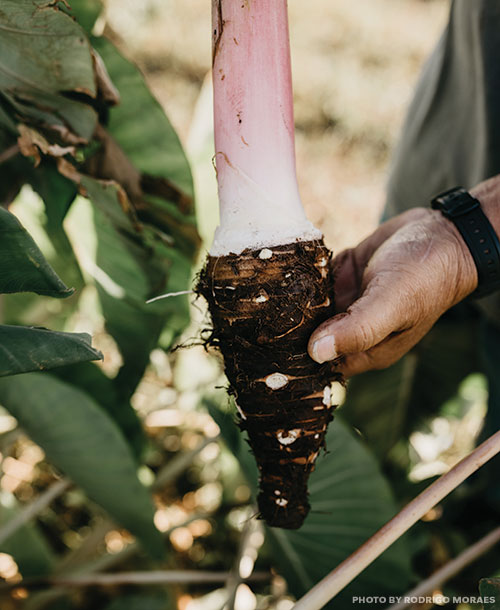
Fisher holds that learning from the past will propel the future of food in Hawai‘i.
“The critical question is: How did our kūpuna [ancestors] have a population roughly similar to [today’s] while remaining 100 percent sustainable?” he says. “We look at ourselves, and we have maybe two weeks until people would be beating down the doors of Costco.”
Fisher aims to address that question firsthand. In 2017, he and business partner Jeff Shaffer launched ‘Ulu Brothers, LLC, on land adjacent to Pahia’s farm. In ancient Hawai‘i, ‘ulu (breadfruit)—along with ‘uala, or sweet potato—served as a secondary staple. Like kalo, ‘ulu appears in Hawaiian mythology, including one version that recounts the god Kū burying himself alive to provide nourishment for his starving family. From his head sprouted an ‘ulu tree.
Fisher and Shaffer agree that, just as interest in kalo is rising, ‘ulu is also experiencing a comeback. Maui Breadfruit Company makes its popular Pono Pies with ‘ulu and other local ingredients, ‘ulu flour is replacing wheat flour as a healthy and gluten-free alternative, and ‘ulu chips are favored as a substitute to corn-based versions. In 2017, Maui Nui Botanical Gardens kicked off its inaugural Lā ‘Ulu (Breadfruit Day) with educational booths, workshops, ‘ulu-infused dishes, and more. Many participants left with potted ‘ulu trees to cultivate at home.
“I think people are awakening to [‘ulu’s] contribution to the islands’ sustainability, and [its role in] the story of people throughout the Pacific,” says Fisher.
Fisher and Shaffer are cultivating two acres of former Wailuku Sugar Company fields, with plans to expand to four acres. Their current acreage will support thirty-six trees—but creating a thriving ‘ulu forest in the rugged Waikapū landscape isn’t so simple.
“Wind is our major hurdle, so we’re doing three layers of windbreak with milo, panax and vetiver,” says Fisher.
The irony of farming ‘ulu on former sugarcane land is not lost on Fisher. Indeed, years of monocrop sugarcane farming have depleted much of the soil’s natural biology, proving an added challenge for area farmers. For Pahia, it’s an opportunity.





